Email Marketing for Startups: Importance, Ideas and Strategies
When was the last time a salesperson showed up at your front door?
As a matter of fact, only a few thousand door-to-door salespeople exist today - mostly for residential construction and building finishing. But the nature of door-to-door selling still offers a few benefits:
- You could build a relationship with each prospect and customer
- You could ask relevant questions and learn about your target audience
- You could personalize every interaction
You don’t need to pack a bag and navigate industrial parks in order to promote your startup anymore. Email marketing delivers all these same benefits - with much less stress than knocking on someone’s door.
Today we will discuss how email marketing for startups is an invaluable step you can take right now. Let’s get started!
Why is email marketing essential for startups?
Incorporating a robust email marketing strategy into your marketing mix is essential because it provides optimal ROI. Plus, emails in your digital marketing toolbox can help you reach a broader target audience who is ready to buy your products/ services. As a result, you’ll drive more web traffic, boost sales, and increase your revenue.
A targeted email list lets you regulate which content your readers will see and read, as well as help you take your business to the next level.
Below are a few benefits of a well-planned email marketing campaign:
- Provides better brand recognition
- Develops long-term brand/ customer relationships
- Reaches a broader target market
- Drives more web traffic
- Increases conversions
- Boosts sales and revenues
4 email marketing ideas for startups
Every kind of startup has different business models, different types of products and services. Even if two startups work in the same field, they’ll have their own persona and brand image.
All these factors determine the exact set of emails you should deliver. However, there are some emails that should be sent no matter what type of startup.
1. Welcome email
Welcome emails should be sent automatically right after someone signs up to your list. It should just introduce your brand and not sell anything:
- A polite thank you for joining your email list
- What they should expect in future emails
- Where to follow your social media channels
- A request to add your business email address to their contact list
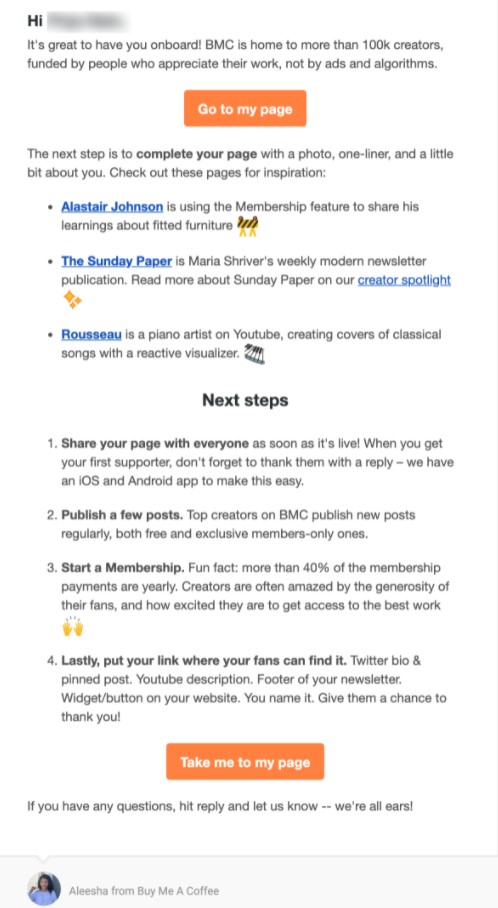
2. Onboarding email
Onboarding emails are a series of emails that you can send after the welcome email.
It works well if you have a product/ service that needs a bit of hand-holding or education. In this type, you can walk them through all the features and benefits one by one.

For any other type of company, onboarding emails can include a series telling people more about products/ services, the brand story, and if there’s any special gift you’d like to offer people for subscribing to you.
Keep in mind that if you don’t evoke any kind of emotions in customers, no one is buying from you. Therefore, the ultimate idea behind onboarding emails is to indoctrinate them to your business by creating an emotional connection or a constant habit.
3. Newsletter
Running a content newsletter not only keeps your brand on top of your audience’s mind but also builds your authority in your niche. Ultimately, that will help you get customers and raving fans.
Your newsletter should include tips and techniques that help people even if they don’t use your product/ service. For example, Harry’s does a good job with its illustrated newsletter on men’s grooming.

4. Sales & product launches
With welcome emails, onboarding, and free content in newsletter emails, you’d have nurtured a good relationship with your prospects. To survive as a business, you need to turn this into a transactional relationship.
That can be done only when you tell your subscribers that you have something to offer. You can run email campaigns telling them all about your new products/ services and even offer special deals.

10 email marketing strategies for startups
In this section, you’ll learn some practical email marketing strategies to start using today and maximize the ROI (return on investment) of your startup.
1. Build your email list organically
You might initially collect emails by some hacks, tricks, or even from the “market.” However, when it comes to engagement, this ultimately won’t yield any good results.
Don’t go after the vanity metric of the email number in your list. Instead, build your email list organically.
Below are 4 strategies you can implement:
#1. Subscription forms on your website
Use pop-up forms on your site so that visitors can easily share contact information and subscribe to your email list while they are browsing your site.
Popup forms can be customized to match your brand, while also giving a punchy reason that can make someone cough up their email address. They can appear once visitors have spent a few seconds or minutes on your website.
For example:
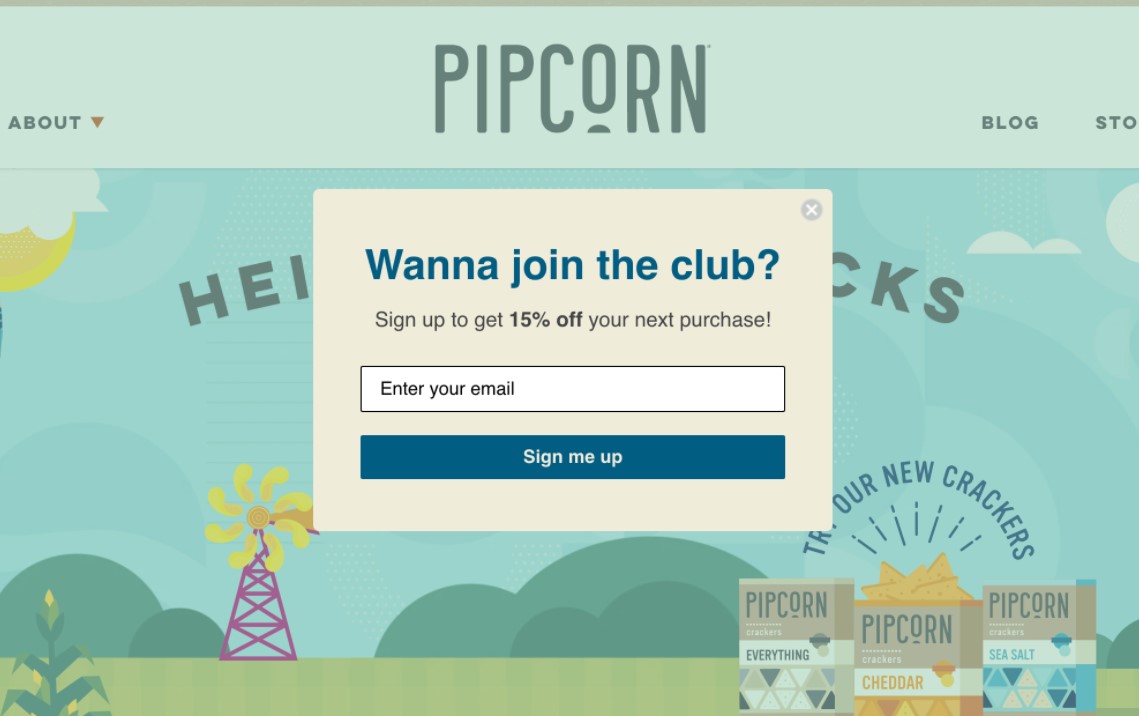
#2. Lead all channels to your email
Use all of your social profiles to highlight your website where people can find a subscription form or explore your content that leads them to sign up.
You can do a post or stories letting people know that they can even get more, richer, and variety of content in your emails. Social media is good to test ideas, build engagement, as well as your brand persona, but most of the transactional relationships will be built over emails.
#3. Advertisements
It’s common to run ads on Facebook or Instagram with your content, which will lead people to your site or landing page. Once on your website, you can convince them why they should actually sign up for your newsletters.
As a matter of fact, running ads isn’t inexpensive, especially when you’re a growing startup. However, once you’ve built your email list with subscribers from your target market, you can promote your products or services to this list. This helps you not only to recover the cost but also make a net profit.
#4. Referrals
Many startups started with just a few people on their email list, and then gained momentum through referrals.
Harry’s is an outstanding example of this. Today, it is a billion-dollar company with a kickass email marketing strategy and probably a few million subscribers on its list.
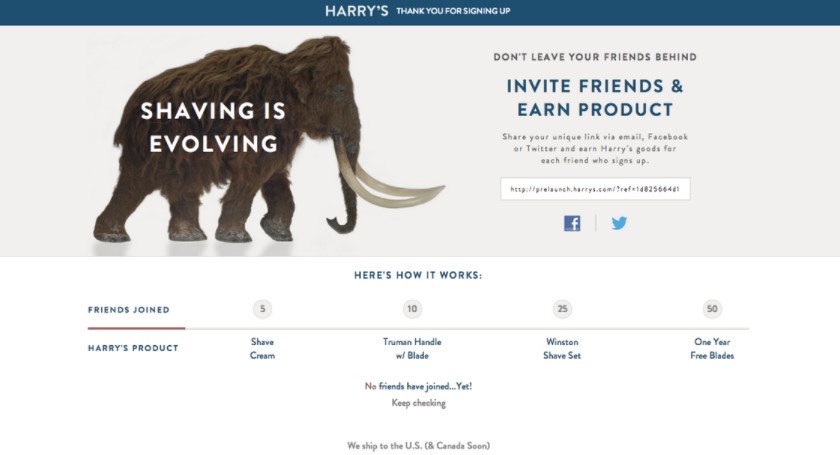
Therefore, in the initial stages of your company, you really need a word of mouth or a referral program, so that more people can know about your business without hiring someone famous.
2. Craft good email copy
Conversions are essential for any business. But before users convert, they must first be willing to click your messages.
In order to convince them to open your emails (and hopefully buy from you), your email copy has to interest them. If you are wondering how to write this copy, consider what interests you first.
When you visit your inbox, which email do you open first? It must be something interesting.
Hooking recipients with subject lines
Let’s take a look at the example from Warby Parker.
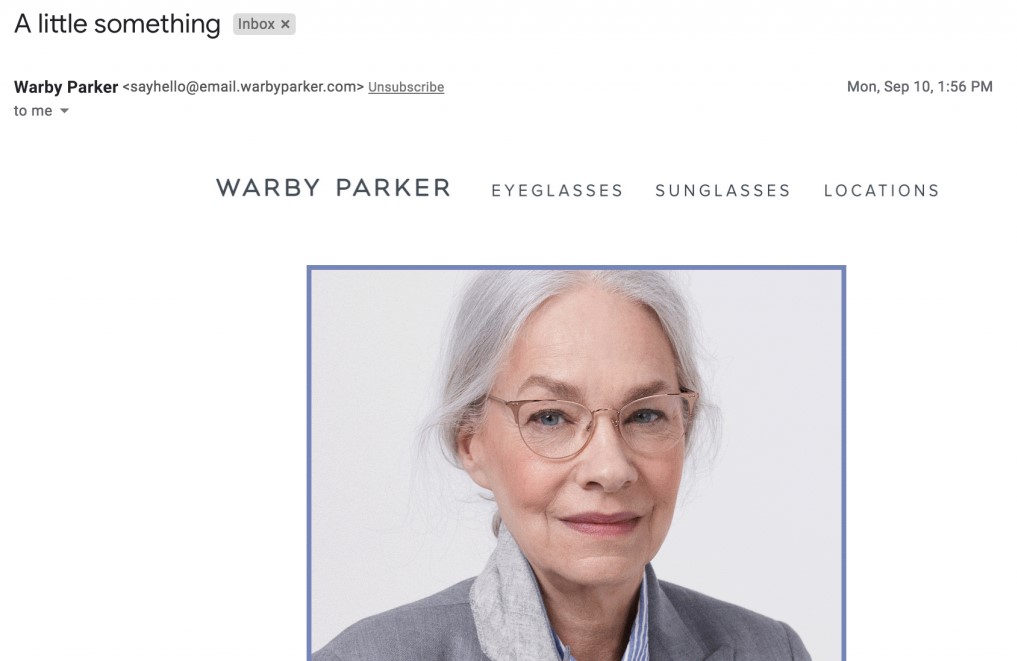
By implementing a curiosity gap, the brand encourages curiosity among customers. As a result, recipients will open the email, whether or not they need new glasses.
Read more:
Reeling in recipients with header pretext
You have more opportunities than just your subject line. You can also engage readers with your header pretext.
Let’s see the example from Glassdoor:

The email subject line is “8 Secrets Recruiters Won’t Tell You.” Next to that is an additional header pretext that says, “Top wellness perks and salary advice, too.”
If you are a job-hunting professional, this offers an entire package: recruiter secrets, wellness information, and financial advice. Rather than rely on a single strategy, the brand is appealing to recipients through the curiosity gap and authoritative copy.
Learn more: Email Preheaders - More Powerful Than You Think
Creating valuable content
You also need high-quality email content inside your campaigns. Your copy should be:
- Concise and get to the point
- Conversational
- Filled with actionable language and active voice
3. Automate your emails
The huge benefit of email marketing automation is that it can save you a lot of time, while ensuring you’re in contact with your prospects and clients. That eventually helps you build strong relationships and increase the lifetime value of each customer.
It’s quite impossible to manually send emails to thousands of recipients. You need a tool helping you streamline the process. And AVADA Email Marketing is an outstanding candidate.
With this tool, you can segment your email lists, schedule emails, deliver automated replies, as well as customize messages to reflect each individual recipient. AVADA Email Marketing offers a package for free, together with paid plans starting from $9/ month, depending on your business needs. Its free plan offers necessary features, which are appropriate for startups.
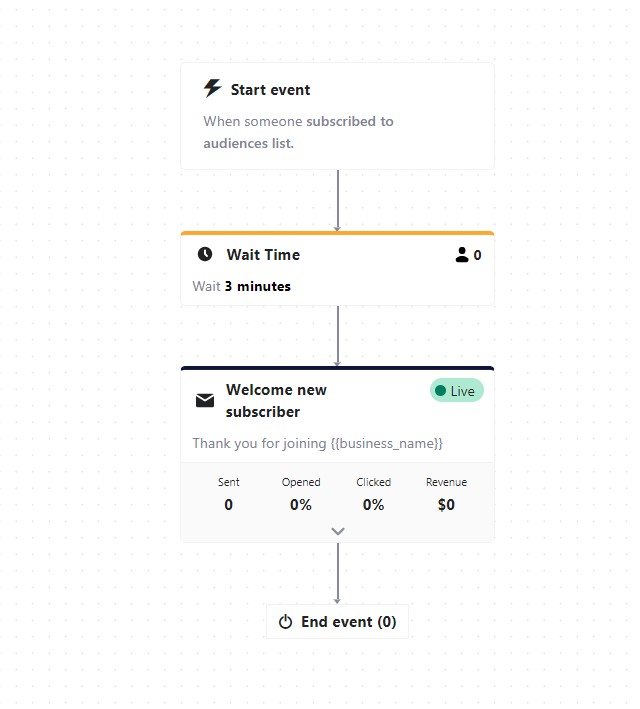
The tool lets you create an automated series that works on your behalf to engage prospects. For example, when someone signs up for your email newsletter, an automated email will be immediately sent to welcome them. The next day, you can deliver an automated onboarding email explaining your company’s different products/ services.
4. Personalize your emails
Personalization is the essential process of developing a product/ service that fulfills or meets your target audience’s needs. This approach involves having your ideal customers in mind when crafting email messages.
Your emails should satisfy the requirements of a specific segment of your email subscribers. Some advantages of personalizing email marketing campaigns include:
- Boost your brand loyalty
- Improve your customer experience
- Enhance customer retention
- Increase your sales and revenue
Email marketing personalization lets marketers use customer’s personal information (i.e., purchasing history) to launch targeted email campaigns. With the data collected from list groups and other channels, you can develop solid email campaigns that your audience can’t resist.
5. Include a clear CTA
One common mistake made by businesses is to create a stunning email design but forget to make the CTA (call-to-action) button clear to readers. Without a clear CTA, your emails can’t reach their full potential, as readers don’t know how to move on to the next step.
The main tips to keep in mind when creating your CTA are:
- Keep the text short and concise
- Ensure the font is bold and legible
- Use a color that stands out in your design
- Make sure that all links are correct before sending
The below email from Lyft is a great example of an effective CTA button. The white button well contrasts with the blue background, and the text is clear and concise.
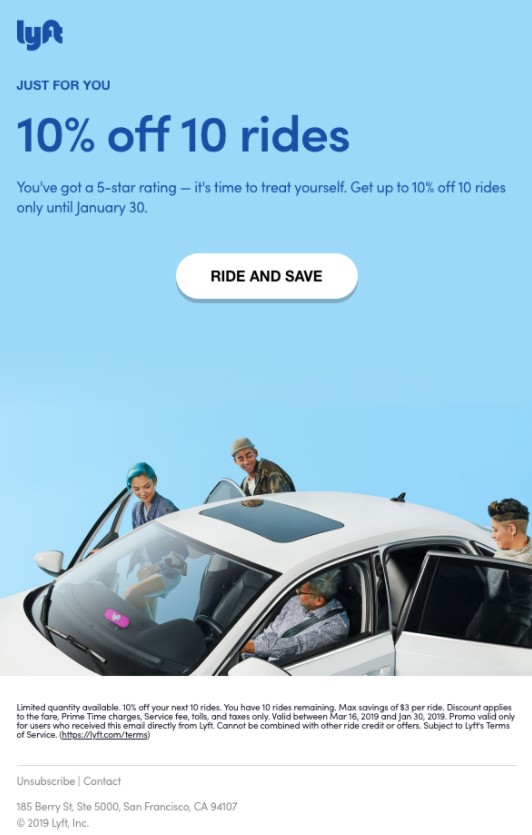
6. Perfect your design
Most people spend about 15 secs reading an email. If your message isn’t well-designed, it could take less than one minute to land in the trash bin. But a well-designed email could entice a new audience in those same 15 secs.
Email design can facilitate your ability to promote your brand and express it clearly and effectively to your recipients. It goes beyond just ensuring that your text is legible and your layout is inviting.
For more useful tips on email design, read our 11 Email Design Best Practices for Marketers.
7. Optimize your emails for mobile devices

Why should you optimize your emails for mobile?
Because people are always using their mobile devices.
It’s vital to create responsive emails. A responsive email can actually adapt and display correctly on any device, whether it’s a smartphone, tablet, or desktop.
While creating responsive emails, remember to:
- Use responsive email templates
- Break up your sentences and paragraphs
- Don’t use heavy images
- Be simple and straightforward in your email copy
8. Stay out of the spam box
Not all your emails are going to reach the inbox. The most effective thing you can do right from the start is to avoid the spam box as much as possible.
It depends on many factors, such as your email software provider, your email content, the response of your audience, and of course, the algorithm of email clients.
The easiest things you can do include:
- Avoid needy, pushy, sleazy, and manipulative subject lines
- Make your unsubscribe button visible
- Proofread your emails to avoid any spelling or grammatical mistakes
- Keep the ratio of text to image 80:20
- Avoid using heavy templates or image-only emails
9. Encourage referrals and testimonials
As we mentioned earlier, as a startup, a great amount of your success will be based on how willing your first customers are to recommend you to others. Before your brand becomes more established, you’ll find yourself heavily reliant on customer referrals and testimonials to attract new customers.
You can take advantage of email marketing to encourage existing customers to share their experience of your business. Many brands operate referral schemes offering the customer an incentive, such as a discount, when they refer your brand to a friend.
This below email campaign from Tictail is an excellent example of how you can advertise your referral schemes via emails and build up a solid reputation for your startup.

10. Carry out A/B testing
For a startup, it can be hard to find a marketing style that works. Email marketing is great, as you have the opportunity to test out various ideas until you’ve found your perfect formula. This is where A/B testing comes in handy.
Whether it is a subtle change like background color or logo size, or a more drastic change like your subject line or intro text, testing both variants with your email list is a great way to see what really works and what doesn’t.
Related topics:
- What is A/B Testing in Email Marketing?
- How to Do A/B Testing Email?
- The Guide for Email Subject Line Testing
The bottom line
Email marketing is a great way to drive revenue and growth for your startup, and you can easily see results with a little bit of care, automation, and knowledge of your user base.
We hope you’ve found this blog post useful and will consider using these above strategies for your email marketing campaigns. If you have any concerns about email marketing, feel free to contact us to get help! We’re always happy to hear from you! Thanks for reading!
New Posts

How To Set Up Google Analytics 4 For Your BigCommerce Store






